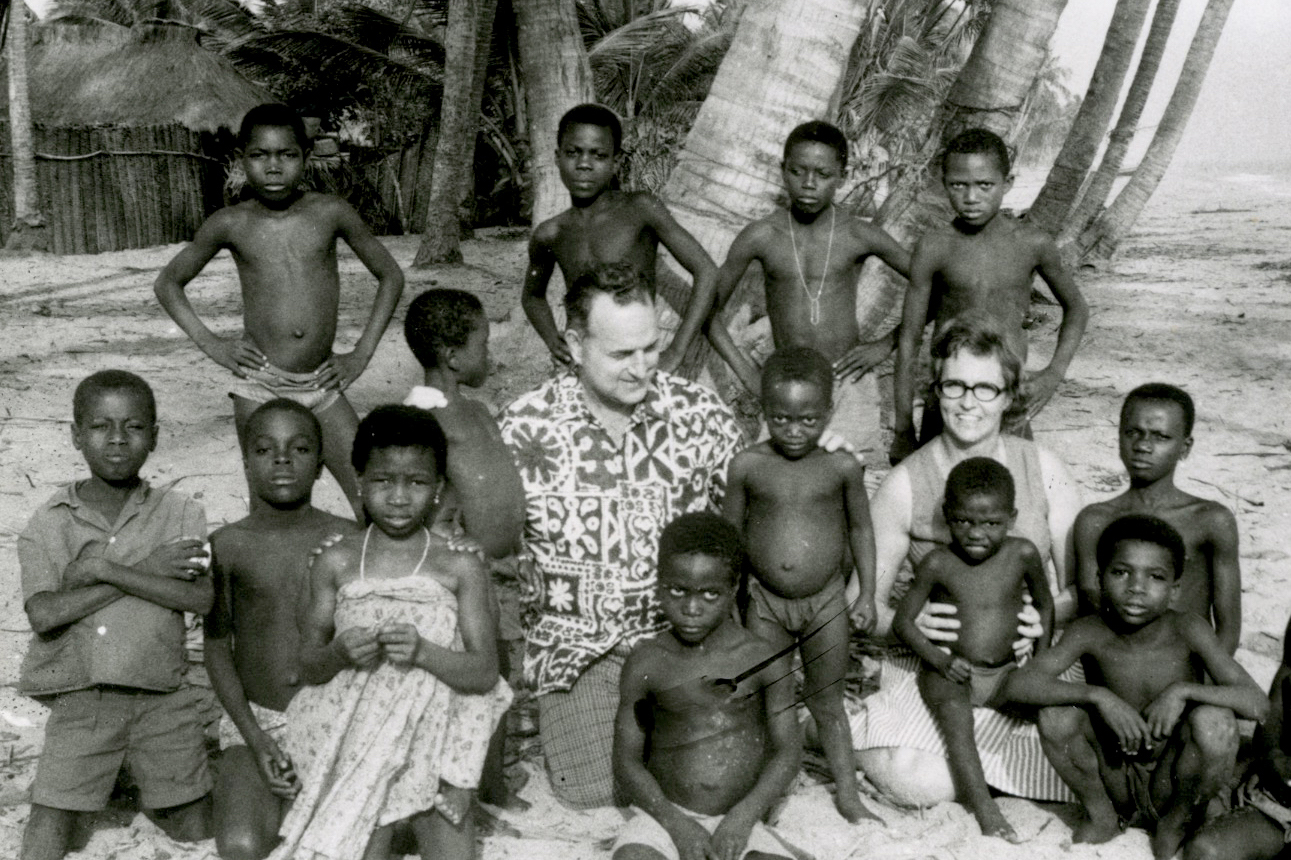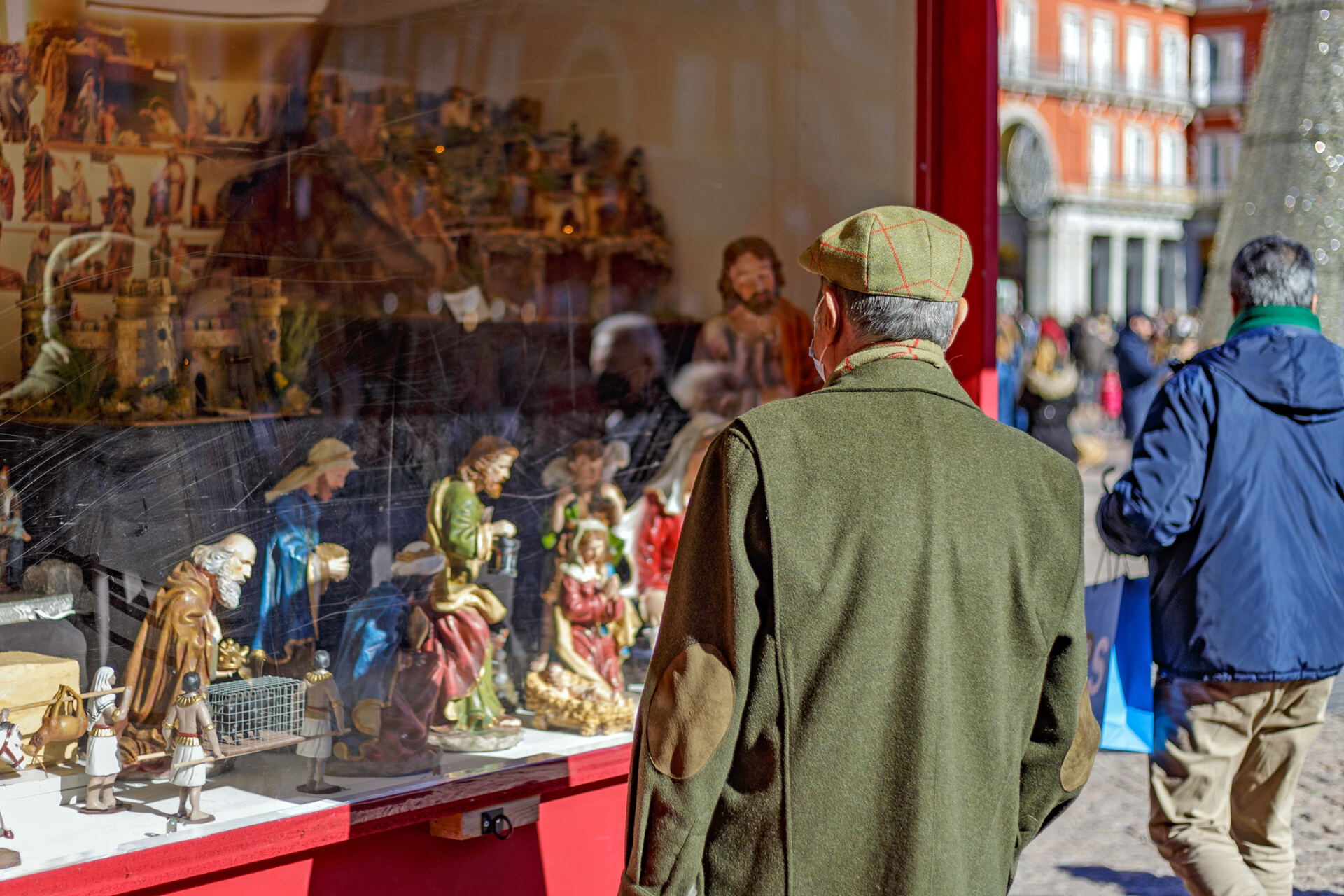After 18 years of serving in Niger, the Washers had set their sights on the country of Benin. Kay later wrote that “settling down there would be like coming home.”1
When they encountered several closed doors in Benin, the Washers and their survey team had no choice but to move on. They left burdened, believing a golden opportunity had slipped through their fingers.
The team decided to drive west toward the border of a small nation called Togo—one of the most densely-populated African countries with 40 distinct ethnic groups, many unreached.
Being accustomed to “stony indifference or blatant rejection”2 of the gospel in Islamic Niger, Dal and Kay were thrilled to find that Togo was different. “[The Togolese] eagerly accepted literature we passed out and requested Bibles in their own language. Children and young people mobbed us as we handed out tracts,” wrote Kay.3

After years serving as missionaries in Niger, Dal and Kay Washer conduct a survey trip with ABWE to Benin, but when they cannot find a place among existing ministries, the team travels to Togo instead. There, they discover a marked difference between the spiritual openness of the Togolese and the people of Niger.
The Washers’ disappointment dissipated. It was clear that God was calling them to Togo. But they realized that if they wanted to make an impact in Togo, they would need a team.
As the Washers dove headfirst into local life, they began to build relationships. These led to evangelistic Bible studies and, eventually, a church plant in Lomé.

In the early stages of their ministry, the Washers evangelize Togolese through outreach events like volleyball in their yard. After playing, Dal leads the young men in a Bible study. These small steps led to the first ABWE church plant in Lomé.
More teammates, including Dave and Elwanda Fields, Tim and Esther Neufeld, and Jim and Carol Plunkitt, joined the Washers by 1977.
As is often the case with missionary teams, additional people meant more ideas and more opportunities for ministry expansion.

The first wave of missionaries to join Dal and Kay in Togo included Jim Plunkitt, Dave Fields, Tim Neufeld and their families.
“Dal Washer had the heart of an evangelist; he had the incessant desire to spread the seed of the gospel all across Togo. David Fields was a gifted teacher who focused on deep discipleship in his church-planting strategy,” explained Andrew Ward, who serves as a field team leader in Togo.
“[I]n hindsight, we can see God’s plan in providing the ministries in Togo with diverse and complementary leaders.”4
With Dal and Dave leading, the ministry in Togo could grow deep and wide. The Washers pushed the gospel into the corners of the country, and the Fields helped train new believers for leadership.
As church-planting progress in Lomé continued and more missionaries arrived to share the load, Dal and Kay felt it was time to take the gospel further into Togo.
They moved to Kpalimé, a city of 30,000 set 75 miles inland.
Years earlier in Niger, Kay’s compassion for the blind, who could only provide for themselves by begging, led her to take courses in braille during a family vacation. From this, she began teaching a few blind boys how to read during her time in Niger. This ministry work extended into Togo, and Kay began the country’s first blind school. She found herself teaching numerous classes and taking every opportunity to teach her students the Bible.

Kay starts Togo’s first blind school in Lomé. Impressed, the Togolese government grants the Washers land on which to build a larger facility called the Village of Light.
MOVING INTO A MANSION
As the school’s successes grew, government officials took notice. With the blessing of Togo President Gnassingbé Eyadéma, the Washers constructed a new blind facility called the Village of Light on land given to them by the government.
After years of teaching in grass huts and vacant shops, Kay described the transition into the new building like “moving into a mansion.”5
The Togolese community remained skeptical of the visually impaired children’s intellectual abilities—until two Village of Light students finished first and third in the regional government exams. Years later at her retirement, Kay was invited to the presidential palace and awarded the civilian medal of honor by President Eyadéma for her work. The Village of Light continues to this day, ministering to roughly 50 students each year.
But the school had accomplished more than education. As more Togolese learned of Christ, the Village of Light fed the team’s church-planting efforts. By the 1980s, the church in Kpalimé was filling to capacity each Sunday.
Dal again resolved to reach deeper into the Togolese interior, not yet knowing that one of the most astonishing acts of God still loomed on the horizon.

The team in Togo expands, starting Bible Institutes in both Lomé and Kpalimé to raise up a generation of Togolese leaders.
A PRAYER AND A TERMITE MOUND
One day, while driving to visit mountain villages in Kpalimé, Dal and Kay pulled over to picnic at an overlook. As they observed the landscape of isolated huts dotting the rolling foothills, they considered how few Togolese had access to quality healthcare.
“Oh God, these lost people need medical help,” they prayed. “Please send us nurses to meet the great need that we see.”6
As the years progressed, the Washers’ prayers grew bolder.
They asked for an entire hospital—and their prayers were heard.
In 1978, a team of surgeons sent by ABWE arrived to survey possible locations for a medical ministry. A local village chief made them an offer: free land in return for a full hospital in Tsiko (pronounced chi-kaw). The land included the very spot where Dal and Kay had first prayed for the medical needs of the people.
The catch? There was not an adequate water source near the future hospital site. The team had no option but to apply to the US Embassy for a special drilling rig.
The rig arrived, and an intrigued crowd of Togolese and Americans swarmed the site to witness the momentous groundbreaking.
There was another catch. The embassy only allowed a limited number of digs, and the rig was not hitting water.
Over and over the drilling failed, until only one dig remained.
A bystander suggested using the tall termite mounds as a reference point. The crew selected a spot near a tall termite mound on the property, figuring the termites had used a nearby water source to keep their “mud castles” intact.7

Dal stands at the construction site of Hôpital Baptiste Biblique (HBB), which officially opened its doors in 1985. In its early years, HBB treats more than 10,000 patients annually. Now, that number has nearly doubled.
The crowd waited with bated breath as the massive bit bored through a tough layer of rock. At last, resistance gave way, revealing an underground lake with more than enough usable water to sustain a medical facility.
The team viewed the discovery as God’s blessing on the project. About six years later, Hôpital Baptiste Biblique (HBB) finished construction.
After years of team involvement and prayers, ABWE had finally launched its first major medical ministry, ushering in a new era of physical and spiritual healing to the heart of Togo.
Lives Well Lived
The Washers spent their remaining ministry years in Togo helping build HBB, church planting, and leading the Village of Light. Dal passed away on the field in 1989 and is buried near seven mango trees on the campus. Each tree represents an African church that Dal planted. Kay had to go back to the US in 1996 after suffering a severe leg injury, but then later returned to Togo one final time in 1999.

Dal passes away from a heart attack and is buried at the Village of Light. Seven mango trees surround his grave, representing the seven churches he planted in Africa. Today, by God’s grace, these original seven have multiplied to 60 churches, all of whom can trace their lineage back to Dal.
Although Kay spent the next 19 years serving stateside at her local church in Greenville, S.C., her heart yearned to be back in Togo.
“As I watch the hospital ministry unfold, I wish I had another life to give to the Lord,” wrote Kay before her passing in 2018.8

On her last day in Togo, Kay is personally awarded the Order of Mono, the highest honor a civilian or foreigner can receive, by Togo President Eyadéma for her faithful work with the blind.
The Washers’ ministries in Africa paved the way for hundreds of other servants to dedicate their lives to Togo, creating thriving teams that exist to this day. Over the course of nearly a half-century, almost 500 ABWE missionaries, from short-term to long-term workers, have served in Togo through the hospital and other ministries—opening countless doors for the gospel.
1. Washer and Gray, K, A. (2007). One Candle to Burn. Harrisburg, Pa. ABWE Publishing.
2. Ibid., p. 144.
3. Ibid., p. 144.
4. Andrew Paul Ward, 50 Years of God’s Faithfulness: A History of ABWE in Togo. Unpublished manuscript.
5. Washer and Gray, One Candle to Burn, p. 196.
6. Ibid., p. 238.
7. Ibid., p. 241.
8. Ibid., p. 247.





